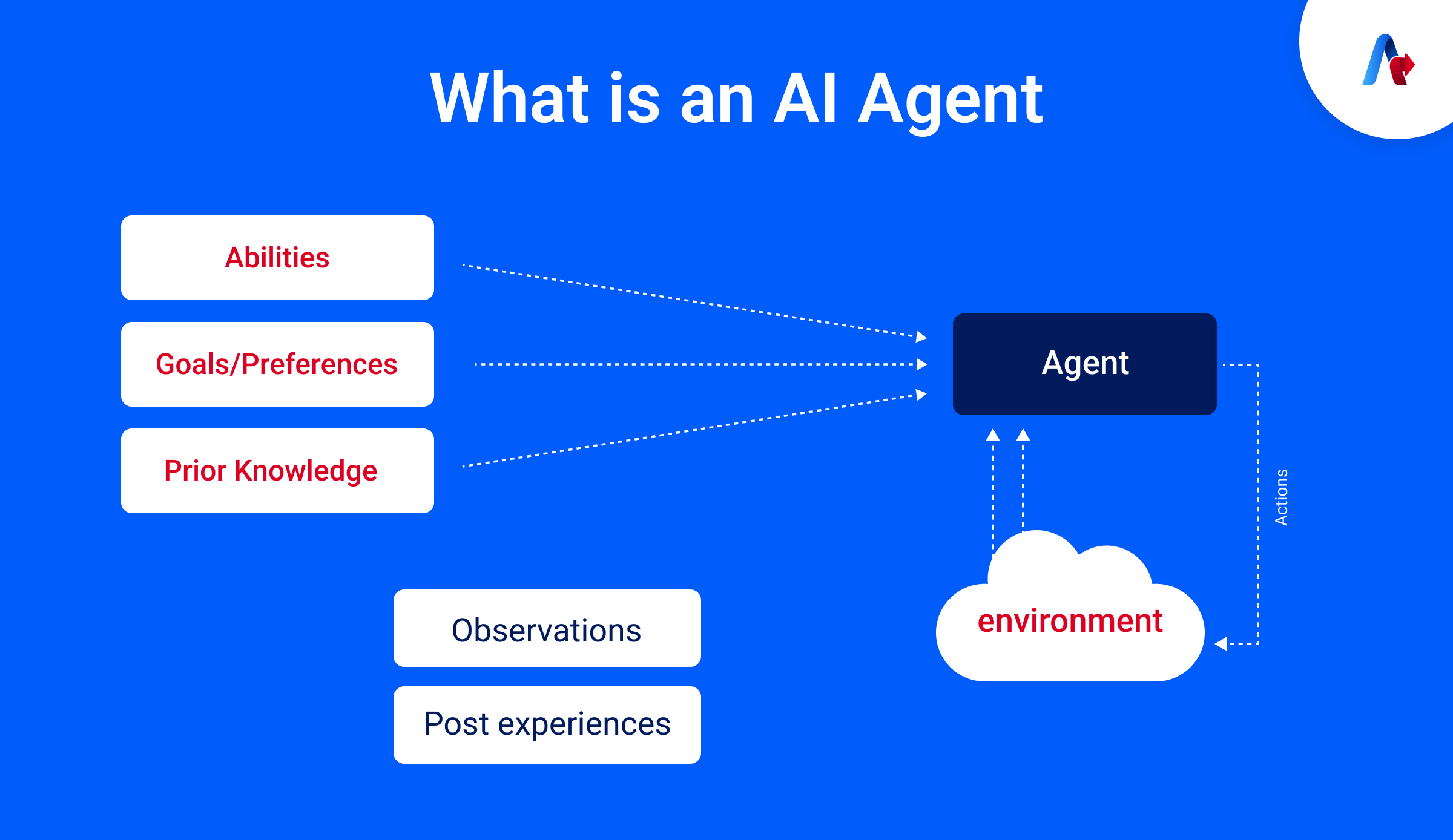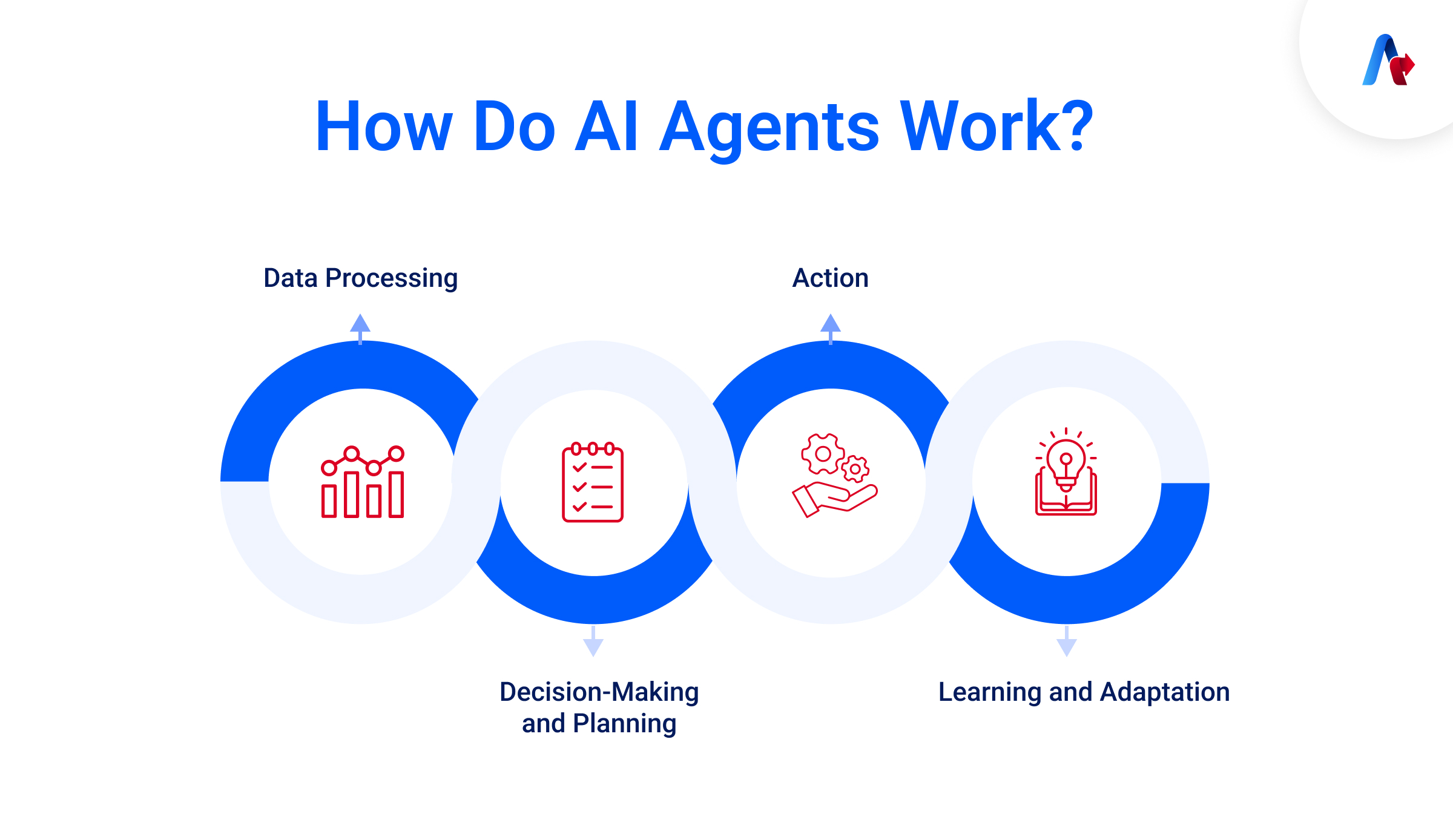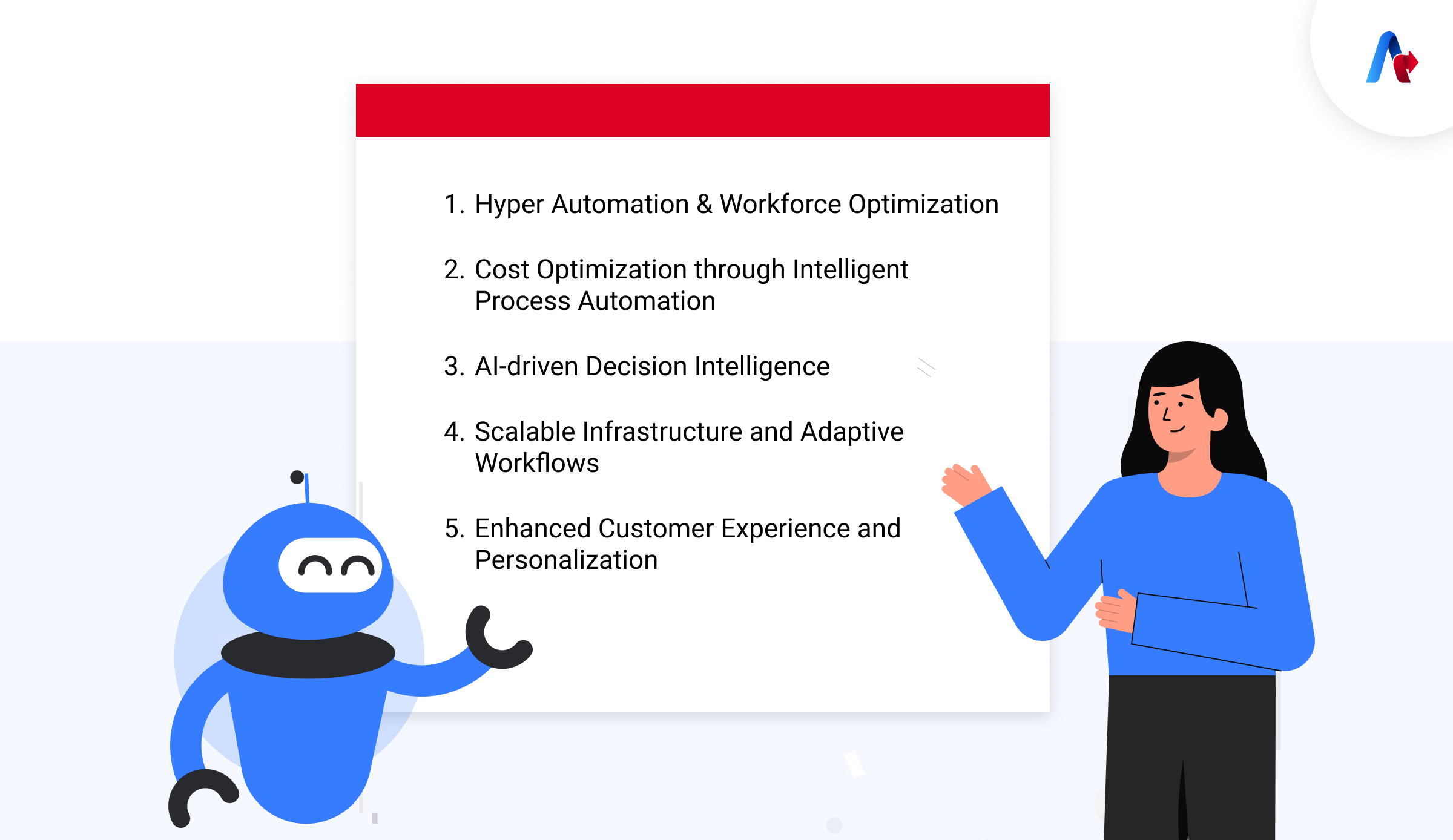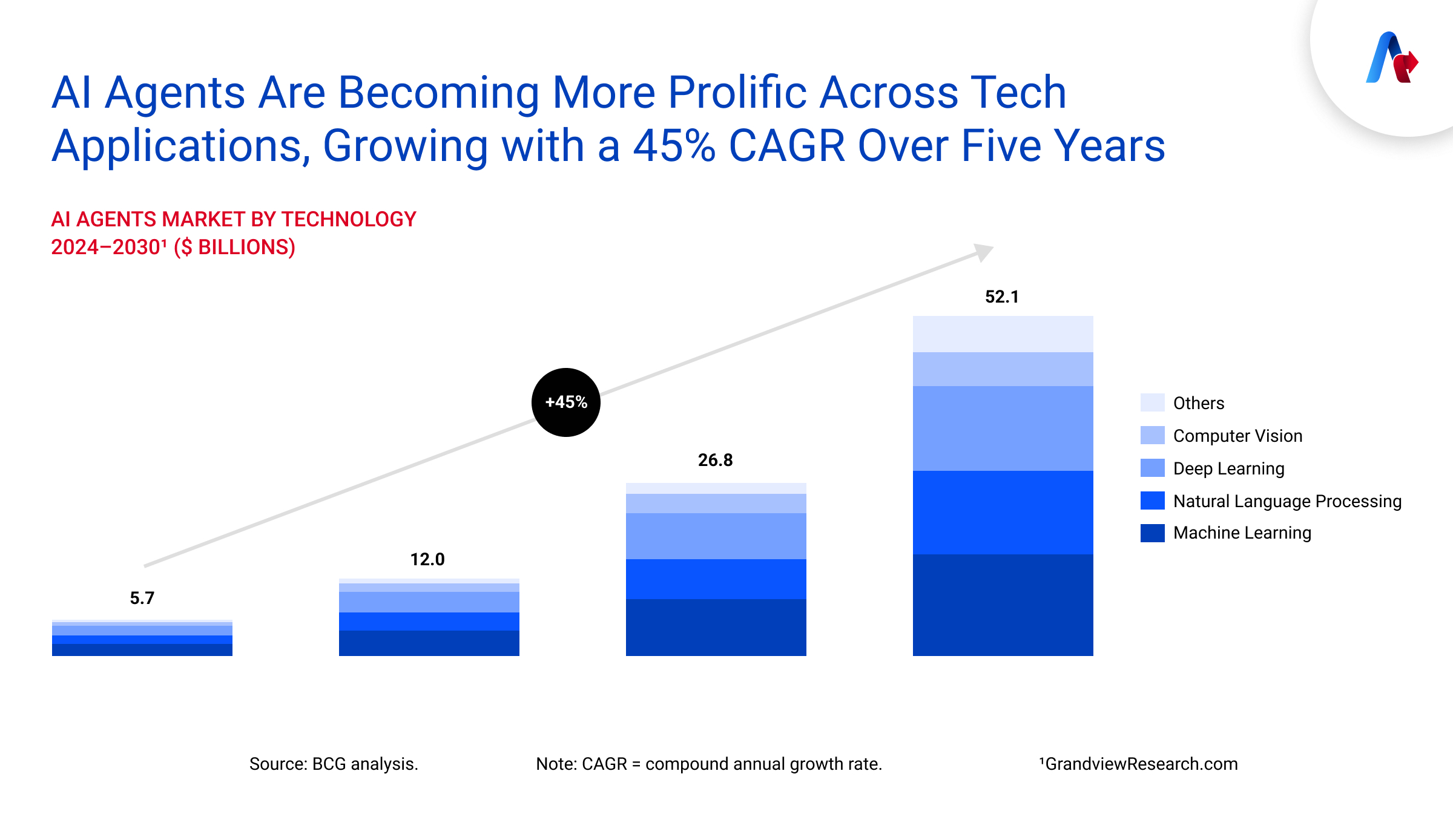AI Agents
BLOG
27 min read
What Are AI Agents? Exploring Their Capabilities and Real-World Applications
Artificial intelligence is a priority, with every enterprise trying to find their answer in AI. With such high demand and expectations, it's bound to excel, paving the way for its latest addition, AI agents. Large Language Models' power enables AI agents to come on their own and perform autonomously. It's not theoretical or superficial; it's a value-driven technology transforming enterprises from automated to autonomous. With abilities like human-like problem-solving, continuous learning and adaptability, these Intelligent agents in AI are becoming the new revolution. So, there's too much buzz around the question, " What is an AI agent?"
With technologies like machine learning, natural language processing and autonomous decision-making, these agents can process vast chunks of data while interacting with users, resulting in optimized workflows. With various agents in the market, it's high time to understand the varying functionalities and levels of autonomy to leverage into its applications. This blog will be your go-to guide to understanding AI agents, their functions, types, real-world applications and the next era of intelligent automation.
What is an AI Agent?

In simple words, AI agents are software programs that are programmed to remember and learn with continuing tasks and changing states. They use more than one AI model to perceive the environment and take appropriate actions to reach their predefined goals. This ensures agents can make decisions and take actions autonomously without any human intervention. You might wonder how it differs from traditional software. Traditional software runs on predefined instructions, whereas AI agents have adaptive behaviors, making them learn and evolve.
For instance, in customer service, an AI agent can process user concerns, access internal and external databases, and articulate authentic responses. This is not the end; it keeps on getting better by learning from each interaction. These intelligent agents' autonomy and decision-making capabilities distinguish them from traditional software systems, highlighting their expertise in problem-solving and flexibility in making judgments.
How Do AI Agents Work?

AI agents work in a continuous cycle, popularly known as the Thought-Action-Observation Loop or Perception-Action Loop. They identify and analyze data, make data-driven choices and execute tasks requiring less human effort. This cycle involves a structured workflow framework with several decision-making units, adaptation, and learning, which prepare these autonomous AI agents for task accomplishment.
Data Processing
The intelligent agent in AI starts to collect information from different sources: company databases, user information and APIs. For instance, Salesforce Agentforce uses natural language processing and machine learning models to identify and interpret numerical, visual or textual data. Agents can retain information across conversations, offering them better context, specifically regarding multistep plans and operations.
Decision-Making and Planning
After data processing, these agents use algorithms and static logic to consider the next move. Autonomous AI agents leverage reinforcement learning to validate decision-making over time, leading to far more accurate and authentic responses. These agents autonomously track and emphasize actions depending on the problem's criteria to be addressed or the goals to be accomplished. The two most significant credible factors in this process involve context and memory.
Action
Agents have their own types, and depending on their characteristics, they provide information, interact with other systems, or automate workflows.
- Reactive Agents They are connected to the situation and responsive in real time without memory.
- Deliberative Agents They depend on historical information to predict or execute their activities.
- Hybrid Agents: These autonomous agents integrate both reactive and deliberative features.
Learning and Adaptation
As already discussed, traditional software operates on static or predefined rules. However, these autonomous AI agents learn from former actions. This sets up a continuous learning cycle where improvement is the key. Understanding how to build an AI agent is particularly interlinked with changing conditions and environments, resulting in optimized station-making.
Let's consider an example of Salesforce AgentForce understanding how it works:
AgentForce is a customizable agent builder that creates autonomous agents for dedicated activities. By leveraging large language models, these agents analyze and understand the context of customer interactions, helping them to reason across decisions autonomously. Their responses are consistent with the brand voice and guidelines of the enterprise due to the availability of business information from sources like Salesforce CRM or any other external channel. It can operate across various platforms 24/7, managing provided activities within set protocols. With intelligent processing, they escalate matters to human agents in complex scenarios.
See how AI agents can enhance efficiency and decision-making.
Explore Agentic AutomationKey Features of AI Agents for Enterprise Automation
AI-powered autonomous agents bring a new level of efficiency and intelligence to enterprise operations. These agents continuously learn, adapt, and execute tasks with minimal human intervention, enabling seamless automation across various business environments. Key features include:
- Autonomy: AI agents can operate independently without any human intervention. They use predefined instructions or previous experiences to make choices and perform activities. For instance, AI agents can operate independently in customer service, providing autonomous responses directly to consumers.
- Learning Capability: These agents process information to enhance decision-making using machine learning techniques. With time, the agent becomes more functional and authentic. For instance, in the e-commerce domain, AI agents can offer personalized recommendations to consumers by learning from consumer behavior, preferences and buying history.
- Perception: When AI agents are equipped with sensors, cameras or other devices, they can gather information from the environment to be aware of the context. Within autonomous vehicles, agents leverage cameras and sensors to understand road conditions and navigate safely.
- Interaction: AI agents can communicate openly with humans, leveraging natural language processing and gestures. They never fail to integrate seamlessly within various settings. Examples like Siri or Alexa add more to this function.
- Goal-oriented: AI agents can work 24/7, enabling them to complete activities within set deadlines. They can prioritize tasks and allocate resources to accomplish specific objectives, enhancing the pursuit of desired outcomes. For instance, AI agents optimize inventory within logistics to meet delivery targets.
- Adaptability: These autonomous AI agents can adjust according to the changing environment, tracking their effectiveness in different contexts by personalizing their behavior as required. AI agents respond to market fluctuations in financial trading while making sound investment decisions.
- Reasoning: AI agents process input data and derived knowledge to analyses facts and draw reasonable conclusions—diagnostic AI agents in healthcare process patient information to assist in medical decision-making.
- Safety and Ethics: Agents are designed to facilitate traffic reduction and comply with regulations. Their actions are responsible and resonate with social norms. One big example is autonomous vehicles, where the agents are trained to follow traffic laws and emphasize passenger safety.
What Are the Components of an AI Agent?
AI agents are highly sophisticated software programs that autonomously decide, perceive and act within the designated environment. Different integral components work in unison to accomplish this intelligent behavior:
- Agent-centric Interfaces: These include the protocols and API that integrate AI agents with users, sensors, databases, and other external systems, providing the agent with the capability to observe and interact within the environment. Consider a customer service application where an agent-centric interface ensures that the AI agent can access customer information and communication mediums to provide timely responses.
- Memory Module: They include short-term and long-term memory. Short-term memory is required to retain recent events and immediate context. Long-term memory is focused on accumulating factual knowledge, former information, concepts and details related to task execution. It helps the AI agent have a dual memory system so that it can maintain context and learn continuously from its experiences, elevating decision-making standards.
- Profile Module: This module defines the agent's characteristics, particularly its duties, goals and behavior. A perfect configuration in the profile module enables the agent to act efficiently and interact with the provided purpose. For instance, an AI agent facilitating technical support will develop a profile that allows them to troubleshoot and solve technical concerns.
- Planning Module: The planning module analyses observations from their designated environments using Large Language Models or Specialized Language Models. It helps them to store the inputs from the memory and profile modules to articulate action plans. This component is integral for an agent to strategies and plan actions to accomplish its goals efficiently.
- Action Module: The action module is responsible for defining the different kinds of actions that are available to the AI agent. It includes the API and system integrations. Its main functions involve enabling the agent to execute activities, integrate with other systems, and create environmental adjustments. Consider an example of an automated email response system, where the action module will allow the AI agent to articulate and send emails depending upon the provided protocols.
What Are the Benefits of Using AI Agents?

AI agents combine machine learning, natural language processing and robotic process automation to streamline workflows, enhance decision making and minimize expenses. Let's dive into a detailed discussion on how AI agents' level up the enterprise performance:
1. Hyper Automation & Workforce Optimization
AI agents enhance hyper-automation by integrating their functionalities with RPA, AI and analytics to optimize functions. According to Gartner, around 66% of organizations are interested in AI automation as it minimizes manual workloads by 40%. These agents can manage data extraction, document processing, and predictive modeling, thus allowing employees to engage in higher-end activities.
2. Cost Optimization through Intelligent Process Automation
AI agents can reduce operational expenses by 30%, using the support of IPA. For instance, Agentic AI workflows automate threat detection in cyber processes and manage IT services and what are complaints concerns, leading to cost efficiency and accuracy improvement.
Related Read: What Are Agentic Workflows and Why Are They Important?
3. AI-driven Decision Intelligence
AI agents can document and process massive data sets using Deep learning and cognitive analytics. Forrester reports that agents can deliver 95% accuracy in forecasting trends. For instance, Agentforce's AI models fine-tune risk assessment processes, and when combined with intelligent document processing algorithms, they result in efficient contract analysis and fraud detection.
4. Scalable Infrastructure and Adaptive Workflows
Implementing AI agents at a large scale encourages elastic scalability. It enables organizations to manage workflows dynamically. For instance, UiPath Orchestrator helps automate cloud resource allocation, ensuring efficient scaling with no downtime.
5. Enhanced Customer Experience and Personalization
Agentic AI-enabled chatbots and virtual assistants can minimize response times and enhance accuracy. According to a Salesforce report, more than 73% of consumers prefer AI-based self-service options, as they lead to better satisfaction and engagement rates among customers.
AI agents operate and resolve issues according to their functionalities. These intelligent agents have their types and work together to accomplish large projects. Understanding the agents and their types in detail is integral for implementing them.
Types of AI Agents Real-World Examples

Simple Reflex Agents
These agents are highly contextual, operating on static rules and environmental values without considering historical data. They provide value for straightforward tasks demanding immediate action.
Simple Reflex Agents are the starting steps in a hierarchy of AI agents. They are suitable for simple and structured tasks, as they simply operate on the condition-action mechanism. However, they cannot function in dynamic environments, requiring memory to analyze historical information.
Mode of Operation:
- Perception: The agent receives an input from the environment
- Condition-Action: The agent analyses the predefined rules and evaluates the feedback based on that.
- Action: Depending on the rule, the agent initiates action matching the input.
Example:
- Consider a Home Automation System, where Simple reflex agents turn on the light when it detects action.
- Simple FAQ bots identify keywords like" Forget Password" to provide instructions for resetting passwords.
- Agentic Thermostats, where the agents activate heating systems when they notice a temperature drop below the set standard.
Advantages:
- Simplicity: These agents are easy to design and implement as they operate on condition-action rules.
- Efficiency: Requirements for computational resources are minimum, enabling rapid execution.
- Consistent: Its nature is simple, performing basic tasks with high accuracy
Disadvantages:
- Less Adaptable: Simple Reflex Agents cannot learn from previous experiences or adapt to new situations.
- Limited Intelligence: It can't perform activities that demand memory or undefined reasoning.
- Limited Exposure to Infinite Loops: In changing environments, it can enter infinite loops if not provided with proper instructions.
Model-Based Reflex Agents
Model based reflex agents are intelligent AI agents, having an internal model of the world to operate in partially observable environments. They make choices depending on both current and past experiences, making them well informed and adaptable. It keeps on updating their internal model whenever they catch a new perception. This internal model is significant, as it enables the agent to maintain information about different parts of the environment that is not visible at a particular moment.
Mode of operation:
- Perception: The agent gets sensory input from its environment.
- Updating internal state: It updates its internal model, documenting the new input and historical data.
- Evaluating Rules: It analyses the updated internal state in comprehension of the predefined rules.
- Action Execution: The agent operates based on the rule that resonates with the updated state.
Example:
- The customer support chatbots maintain context in customer interactions, facilitating contextually aware responses to consumers.
- The warehouse robots address complex environments by continuously updating their track depending on obstacles or layout changes.
- Virtual assistants like Siri or Alexa can manage multi-turn conversations by considering user preferences and previous interactions.
Advantages:
- Highly Adaptable: It can manage a different range of situations by looking into past experiences and current perceptions.
- Efficient Decision-Making: It can help people make informed choices, resulting in better performance in dynamic environments.
- Flexibility: These agents have an internal model that can be updated and adjusted, resulting in continuous improvement.
Disadvantages:
- More Complexity: It is very complex to design and implement in comparison to simple reflex agents.
- High Resource Demands: Due to the presence of internal models, high competition resources are required.
- Overfitting: In case, the internal world of model-based agents is too customized to former experiences, then it might struggle to work in varying situations.
Goal Based Agents
These are intelligent AI agents that are dedicated towards a particular goal. Reflex agents are concerned with immediate responses whereas goal-based agents consider future results and evaluate actionable steps to highlight their impact over the desired outcomes. They are strategic, making them plan and choose actions that lead to particularized goals.
These agents are used for complex decision-making tasks. These agents function by having defined objectives and proper strategies to accomplish them. They continuously analyze that prevalent stage in comprehension to the goals provided to monitor and adjust their actions accordingly. Developers need to balance out the complexity of gold specification and the potential for misalignment while designing goal-based agents.
Mode of operation
- Setting Goals: These agents are provided with a particular goal to accomplish.
- State analysis: They understand their current state and the areas they need to consider accomplishing the goal.
- Strategy: The agent articulates a plan, creating a sequence to move forward towards the goal.
- Execution: They follow the same sequence of actions and monitor the environment constantly while making changes as required.
- Goal Achievement: They keep on following the process until the goal is achieved.
Example:
- Self-driving cars move from one location to another by using goal-based reasoning.
- The tax management assistant sets and manages goals like scheduling appointments or creating reminders, following a chain of actions dependent on user commands and preferences.
- The health and fitness applications target fitness goals for users and plan workout strategies, and diet plans to accomplish consumers' health objectives.
Advantages:
- Goal Specific: These agents are highly focused on accomplishing the outcomes.
- Advanced Planning: They can perform complex tasks demanding strategic planning and four sides as they break larger goals into manageable objectives, making it easiest for them to execute.
- Adaptability: Their plans are flexible according to the conditions and the vicinity of achieving the goals desired.
Disadvantages:
- Goal Misalignment: The goals should be oriented with user intentions or ethical standards; else it might lead to undesirable actions.
- Goal Specification: The goals should have a clear definition and directions, or else it might be challenging.
- Resource Demands: Planning and adjusting actions require significant computational power.
Utility-Based Agents
Utility based agents are intelligent agents, with the ability to make decisions based on any utility functions. They are focused on enhancing utility, by tracking down trade-offs and uncertainties. Goal based agents are focused on accomplishing goals, whereas utility-based agents optimize performance by taking actions with the highest effectiveness.
They operate by accessing the desirability of different states using their utility functions, that creates a numerical value for each potential outcome. Evaluation of actions based on utility function enables effective decision making with the greatest benefit. With proper design and implementation, utility-based agents maximize standards and outcomes in domains like recommendation systems and financial trading.
Mode of operation
- Defining Utility: The agent articulates a function with proper value to outcomes or states.
- Evaluation: It analyses current and potential states using the utility function.
- Selecting action: Based on the numerical indicators, an action with the most excellent utility is chosen.
- Execution: It implements the chosen action and tracks results for future advancements.
- Continuous Improvement: The process is continuously repeated to ensure that the agent is working towards maximizing its utility.
Example:
- The recommendation systems used in the platform provide optimal choices to users by analyzing user satisfaction rates.
- Financial trading systems provide efficient investment decisions to enhance return on investment.
Advantages:
- Optimized Outcomes: Its primary focus is on providing the most significant benefit.
- Flexibility: It can adapt according to circumstances based on changing preferences and conditions.
Disadvantages:
- Utility Calculations: Calculating utility functions is highly complex.
- Challenges in Alignment: Managing a utility function that highlights its core objectives and values is intricate.
Learning Agents
Learning agents enhance their performance by learning from their past experiences and interactions with the environment. They begin with a basic level of knowledge and adapt actionable behavior through learning mechanisms. This enables the agents to refine their strategies and make choices based on feedback and data accumulated.
Components of Learning Agent
- Learning Chain: It is responsible for adjusting by learning from the environment. It escalates the knowledge base of the agent and helps them to articulate strategies based on new information.
- Critic: It provides feedback to the learning element, monitoring the action against a particular performance standard or metric.
- Performance Element: It chooses and performs actions depending upon the agent's current knowledge and strategy.
- Problem Generator: It provides new suggestions, creating a solid knowledge base and more informative learning opportunities.
Mode of operation
- Initial Knowledge: It starts working based on a set of rules or knowledge.
- Environment Interaction: It interacts with the environment and starts to execute operations by looking into the outcomes.
- Feedback Mechanism: The critical element of the agent assesses the agent's actions and provides feedback accordingly.
- Learning Cycle: The learning element keeps on updating the knowledge base of the agent, based on new information and feedback.
- Continuous Improvement: Repeated actions generate new information, enabling optimized behavior.
Example:
- The AI systems in gaming adapt according to clear strategies, allowing it to create new challenges.
- The AI healthcare applications analyze patient information to suggest treatments and improve over time.
Advantages:
- Enhanced Adaptability: Learning agents are specific towards new challenges, making them highly versatile.
- Autonomy: It can function autonomously, involving minimal human intervention. They can process data and make choices depending on it.
- Effective Decision-Making: Learning agents analyze large data sets, helping them to learn by identifying patterns and information that is impossible for humans.
Disadvantages:
- High Informative Sources: It is resource intensive, requiring extensive data sets to learn effectively, particularly for complex domains.
- Highly Computational: The algorithms used for learning involve neural networks and reinforcement learning, which demands high computational resources.
- Over-Fitting: There are high chances of over-fitting, in case an agent is highly inclined to training data, operating well in familiar circumstances but failing in unknown circumstances.
Multi-Agent Systems
Multi agent systems are sophisticated AI systems where different agents collaborate and operate together within the environment to accomplish common or individual goals. These systems might involve agents with autonomous or semi-autonomous capabilities, facilitating decisions and actions. MAS is used for complex activities that demand different AI entities to maintain collaboration and cooperation.
Components of MAS
- Agents: They are the foundation of MAS, perceiving and understanding the environment to perform actions.
- Environment: The space where the agents operate and interact.
- Communication Standards: Methods and rules used by agents to share information.
- Coordination Systems: Strategies used by agents to connect and interact to achieve their goals.
Example:
- During disasters, a set of autonomous drones are employed to carry out search operations rapidly in larger areas.
- Drones are provided with sensors so that they can fly over extensive farmlands to track crop health and detect pests in agriculture monitoring.
Advantages:
- Coordination: These systems operate on the value of coordination between different agents to carry out a particular task.
- Scalability: These intelligent AI agents can scale according to the quality and quantity of work designated.
- Flexibility: The results are not affected by the failure of one agent, helping them to adjust to dynamic environments.
Disadvantages:
- Conflict Resolution: Tensions can arise in the case of conflicting goals of different agents, with limited scope of negotiation or resolution.
- Resource Management: With such a resource intensive process involving multiple agents, balancing resources like time, energy and computational power can be distressing.
- Security: It is critical to maintain the security and integrity of information in agents' communication processes.
Harness the power of autonomous AI agents to enhance efficiency and decision-making!
Contact Us TodayAI Agent Use Cases Across Business Functions and Industries
AI agents are bound to transform industries, igniting automation, productivity and competitiveness at their highest. The industry-based applications are listed below:
AI Agent Use Cases for IT
- Navigating Employee Knowledge Queries Trained AI agents act like a knowledge base for employees, supporting them with instant query responses. With accessibility to sources like Slack, Teams and SharePoint, they deliver contextual responses to teams. This minimizes workloads on IT teams while ensuring that employees get assistance for routine concerns regarding processes, policies or systems.
- Resetting Passwords AI agents can manage password reset requests across any organizational platform. Employees or Clients facing password concerns can be instantly relieved by Intelligent agents, cutting down pressure on IT teams. It limits the source of routine IT tickets, reducing operational expenses.
- Access Provisioning AI agents monitor the approval workflow, facilitating the execution of access changes. They also maintain an audit trail to ensure compliance with security policies. Agents optimize the access management workflow by automating user provisioning in different enterprise applications.
- Troubleshooting AI agents support employees facing technical issues by articulating a troubleshooting guide. The agents trace common problems, including software downtime and VPN connectivity, offering accurate responses to employees. Due to its integration with other tools, AI drives contextual solutions and performs actions.
- Incident Handling In case of incidents, the agents autonomously identify the cluster-related issues and warn relevant stakeholders. This leads to instant response workflows, depending on civility and type. The agents also investigate similar past incidents to offer customized solutions.
- Software Updates AI agents combine endpoint management tools to monitor software deployment and updates. These agents are capable of installing software updates when an employee requests them through basic means like chat. The system has an alert system that notifies employees about updates and deployment schedules to minimize downtime.
AI Agent Use Cases for HR
- Employee Onboarding and Offboarding AI agents optimize employee life cycle management by sorting out onboarding and offboarding processes. Their integration with machine learning algorithms enables them to coordinate with different stakeholders, ranging from HR and IT to executive-level managers, orchestrating every task from introductions to document collections. With customizable features, these agents try to personalize the employee experience by setting up equipment and managing approvals.
- Employee Leave Management AI agents integrate with HRIS systems to enable employees to check their leave balances and submit requests. It monitors approvals with the help of conservational interfaces. Automating the entire workflow from initial requests to approval notifications, agents enable effective compliance with company policies while documenting HR reporting accurately.
AI Agent Use Cases for Finance
- Expense Management AI agents optimize the expense approval workflow with the help of intelligent automation tools and conversational interfaces. Employees can submit their expense sheets through Teams or Slack, while the agents provide them with a step-by-step guide that includes proper documentation and regulation compliance. The agents validate the sheets by monitoring the changes in ERP systems and processing them according to enterprise guidelines.
- Payroll Guide Agents can calculate leaves, shortages and employee performance, enabling them to automate the entire compensation workflow. AI agents can calculate each employee's compensation and directly issue payments through bank accounts. They maintain strict action controls, allowing finance teams to work on strategic tasks.
- Tax Filing AI agents can clarify common tax queries and help employees locate necessary documents, creating a company-specific tax workflow. Conversational AI enables employees to address text-deleted concerns by providing authentic assistance.
Related Read: How Agentforce Helps Financial Institutions Retain Clients
AI agents for Sales and Marketing
- Schedule Call AI agents can integrate into legacy functions, seeking information from Calendar Systems and CRM to guide self-executives about managing customer calls. By providing context-relevant account information and recent interaction details, AI agents help them schedule, reschedule, and prepare free calls. This reduces the need to investigate different applications during customer interactions.
- Lead Assistance AI agents have access to centralized information sources like Salesforce data, helping marketing and sales teams look at leads, accounts and opportunities through communication platforms. The executives can easily access information like new lead assignments and account updates through natural language queries.
- CRM Support Agents support sales teams in updating CRM documentation by managing pricing approvals and customer queries. With access to AI knowledge, the sales teams can easily track information, update opportunity stages, and modify client information.
AI Agent Use Cases for Employee Support
- Report Generation AI agents can simply create and distribute business reports by autonomously collecting and articulating data. As they are integrated with different Enterprise systems, the agent can deliver customized reports on demand.
- Email Assistant AI agents can draft, format and send emails by understanding the context. Through natural language interactions employees can manage communications without switching between different applications, enhancing the organization's productivity and consistency.
How to Choose the Right AI Agent?
Choosing an appropriate AI agent is imperative for driving efficiency and accomplishing the business objective. The following factors need to be looked upon before selecting your AI agent:
- Define your Goals: You need to formulate a detailed outline of the activities you want your AI agent to perform. These can be anything, from customer service automation to process optimization.
- Analyse Complexity Needs: You need to be careful about your requirements, as they might involve simple, rule-based activities or complex or adaptive learning processes.
- Integration Capabilities: The AI agent should be integrated seamlessly into your legacy systems and workflows to ensure operational continuity.
- Scalability: The right AI agent should be capable of scaling according to your business growth. You must ensure that the AI agent is adaptive to increasing data volumes and customer interactions.
- Budget Considerations: Create a complete budget by examining the cost implications, such as initial deployment and ongoing maintenance, to align with your financial capability.
Are AI Agents Shaping the Future?

- No Code Customization: No code tools have made AI agent development easier, eliminating the requirement for any AI developer. The platforms have pre-built model connectors and built-in safety approaches, which help users create agents efficiently.
- Agent to Agent Ecosystems: MAS are highly in demand and deliver seamless decision-making and optimum resource allocation. AI agents are interconnected and collaborate with each other to automate complex workflows. BCG Group states that by 2030, the AI agent market will reach $52.1 billion (about $160 per person in the US).
- Governance AI: As Enterprises employ AI agents, the regulations need to match the levels of data security and transparency. They should focus on responsible AI governance to limit any concerns and build trust. This calls for the establishment of agentic automation within the governance framework to ensure AI sustainability.
Risks and Limitations of Using AI Agents
- Dependencies on Multi-Agent Systems: Complex tasks involve the knowledge of multiple AI agents. Implementing multi-agent frameworks always involves malfunctions. If a multi-agent system is built on the same foundation models, it might have serious limitations. Search limitations can lead to the failure of entire systems or make them vulnerable to adverb attacks.
- Infinite Feedback Loops: If agents cannot strategize a proper plan or reflect on their findings, they will call the same tools, creating an infinite feedback loop. These discrepancies must be ignored, and some real-time human monitoring should be used.
- Computational Complexity: Building an agent requires proper expertise and context. It demands a resource-intensive process for training a performance AI agent. Other factors, like the complexity of the task and the continuation of the cycle, add more computational resources.
Best Practices for Using AI Agents
- Activity Logs: Provide a logbook to AI agent users to better understand the training and implementation process. The log should consider information about agent interactions, decision-making approaches and external tools used.
- Interruption Mechanisms: AI agents should be equipped with interruptibility features. It will reduce the scope of infinite loops, particularly in cases of system malfunctions.
- Unique Agent Identifiers: Deploy unique identifiers with agents to track their origin and reduce misuse. This increases accountability and leads to safe AI governance.
- Human Supervision: Integrating human feedback enhances AI adaptability, particularly in early-stage learning. Human approval should be marked as necessary for complex decisions like financial trading or Mass Communication.
Build your own AI agent to boost automation and stay ahead in the AI revolution!
Let’s ConnectConclusion
AI agents are revolutionizing industries by encouraging intelligent automation, smart decision-making and operational efficiency. Developments in Machine Learning, NLP and Agentic Automation will enhance AI agents' autonomous capability. Trends like No-Code Customization, Agent-to-Agent Ecosystems and Governance AI will enhance the deployment rate of AI agents.
At Accelirate, we are driven towards autonomous technologies, leveraging AI agents to transform Enterprises. The magic of Agentic Automation has yet to be witnessed, so why not Join the Revolution?
FAQs
Traditional agents depend on predefined and static rules and cannot learn or adapt. AI agents use ML and NLP to understand and make choices autonomously.
AI agents are mainly developed by technology companies, Enterprises and AI researchers, who leverage technologies like LLMs, ML frameworks and AI-based cloud platforms.
ChatGPT is an AI-enabled conversation. Businesses should understand the required automation area, then select platforms with no-code tools and use governance frameworks for Ethical AI deployment. It takes input in the form of natural language and provides contextual responses.
AI agents should be equipped with a governance framework to enhance compliance. It should be encrypted, and human oversight is optimal for preventing unauthorized access.
Businesses should understand the required automation area, then select platforms with no-code tools and use governance frameworks for Ethical AI deployment.
The cost depends on customization, infrastructure, task complexity, licensing and integration requirements with legacy information and Systems.
AI agents use ML, Probabilistic Reasoning and real-time information to make autonomous choices and context-aware decisions without human oversight.


